

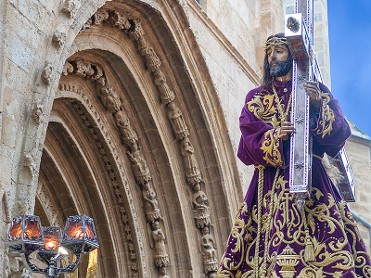
ORIHUELA
Telephone: Tel.: 96 530 46 45
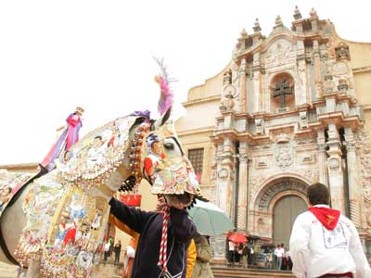
CARAVACA DE LA CRUZ
Every year, thousands of visitors go to Caravaca with the sole aim of having a good time and participating in this celebration, held from 1st to 5th May, which include two unique shows: the festivities of Moros y Cristianos (Moors and Christians) and the Caballos del Vino (Wine Horses).
The festivity of Moros y Cristianos commemorates the fights which took place in the Middle Ages, at the time in which the Murcian town was a border area with the Reino Nazarí of Granada. "Kábilas" (places of Moorish side) and Christian groups walk in file with sultans and kings, wearing their best costumes and making people getting up from their seats at the rhythm of spectacular Moorish marches and amazing choreographies.
The 2nd May Caravaca celebrates the most intense day of its festivity, with the mythical race of the Caballos del Vino, a competition which honours the tradition, the force of the nature and the symbiosis between men and horse.
More than 60 "peñas" (typical Spanish groups) compete in a race against the clock, with their mounts. In this way, it is remembered the moment in which a group of Christian knights managed to break a siege imposed by Moors, wearing wineskins to quench the growing thirst of the prisoners of the alcázar (fortress).
The thundering sound of the galloping horses, the beauty of the embroidered robes, the music, and of thousands of people dressed in white and red, make that the whole city changes.
More information Special Fiestas Caravaca de la Cruz 2015

C/ Mayor, 24
30162 SANTA CRUZ (MURCIA)
Telephone: +34 968 81 29 01
A alabar a la Madre de Dios. A eso se dedicaban los conocidos como "Auroros" entre los siglos XVIII y XIX. Se trata de miembros de hermandades o cuadrillas que se dedicaban a cantar o a alabar a la Madre de Dios entre la noche y el día. Los Auroros son los continuadores de una tradición religiosa-folclórica que consistía en salir en procesión de noche o con las primeras luces del día haciendo replicar campanas y entonando cánticos religiosos. A esta tradición Díaz Cassou la denominó "el alma de Murcia".
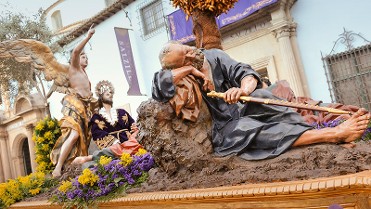
MURCIA
Telephone: +34 968 210 436
Anyone attending a procession in Murcia for the first time, specially one of the most popular processions, will witness a series of astounding images that have no equal in Spain. A celebration such as the Holy Week only gains personality and difference through the years, and Murcia counts on some Brotherhoods from the Middle Ages: the beginning of the 15th Century, when the plague and famine devastated a population left at random, that turned to faith in order to look for a remedy. In the year 1400, a river of blood started up. That blood dyed the dresses the same red that fiercely covered the body of Christ with pain. Time after that -centuries after that-, with the ups and downs of history, the Brotherhoods multiplied until they reached the splendour and vitality they are so proud of today.
We are talking about 15 Brotherhoods: fifteen associations, each one with thousands of moved processionists that turn into estantes, penitents or musicians responsible for the sound that accompanies and characterises certain parts of the processions -the long sound of the tubas, instruments that are as huge as the groans they produce.
Let's talk about some more figures. During the days of the processions, starting with the Viernes de Dolores -Dolores Friday-, more than 80 groups go through Murcian streets. It is a true open-air religious art exhibition that summarizes almost five centuries of the Murcian imagery's development. Important artist names are Francisco Salzillo, whose mention brings to mind the Baroque, skill, tact, depth and moving beauty, and also Roque López, Domingo Beltrán and Nicolás de Bussy, all of them great sculptors, honourably followed on the essentials by the artists of the present century.
People coming to this city for the first time will be able to verify that Murcian generosity is not just literature but also a real thing, and that it is even present at its processions. The processions have turned something that used to be a necessity into a very peculiar characteristic: people brought some food from the huerta -irrigated areas used for cultivation-, where they lived, to the city, to be prepared for the procession's long route. That is why today, from the swollen bellies of the Nazarenos, all kinds of presents come out. These presents can be fresh broad beans or sweets, pastries or hard-boiled eggs; it is a celebration full of generosity, maybe difficult to understand at first. Despite this, that generosity has much to do with the spirit of these days, when the greatest generosity ever is commemorated: the generosity of offering the own life to the others.
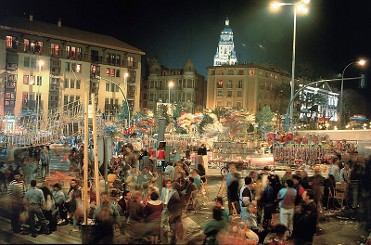
Agrupación Sardinera de Murcia. Calle Cuartel de Artillería
30002 MURCIA
Telephone: +34 968 25 03 80
The Entierro de la Sardina (Burial of the Sardine) is the end of the Fiestas de Primavera (Spring Festivities) which are held in Murcia. In this way, the Entierro de la Sardina is the craziest and wild night of Murcia.
This Saturday on April, a crazy parade with "gigantes" and "cabezudos" (giants and oversized heads), "hachones" and "titiriteros" (firebrands and acrobats), "demonios" (demons) and Brazilian groups of samba guard dozens of floats. Each of these floats belong to a "agrupación sardinera" (sardine association), who give out thousands of toys to the assistants in honour of the Gods of Olympus. During the previous days, the comparsas (troupes) of each "agrupación sardinera" liven up the city with parades.
The day before the Entierro, at night, the Will of Doña Sardina is read from the balcony of the City Council. These festivities end at dawn, when the last float is put away. Then the statue of the Sardine, made of stone and cardboard is burnt in the Plana de San Francisco in the popular revelry.
For more information http://www.entierrodelasardina.es/

MURCIA
Telephone: +34 968 35 86 00
This is the most important day of the Fiestas de Primavera (Spring Festivities) of the city of Murcia. The celebration starts early in the morning with an offering of flowers to the Virgin of the Fuensanta, patron saint of the city. This offering takes place in front of the baroque façade of the Cathedral. Thousands of Murcian people and visitors, dressed in traditional Murcian clothes: huertano costumes, accompany the Virgin during a short walk around the city centre and, especially, will bring life to the huge parade which will go across the streets of the city in the afternoon. As well as this great parade, you'll be able to enjoy ox-drawn waggons, folkloric groups of all the "peñas huertanas" (huertano groups), and rolling barracas (stands) from which broad beans, black puddings and sandwiches are thrown to the spectators.
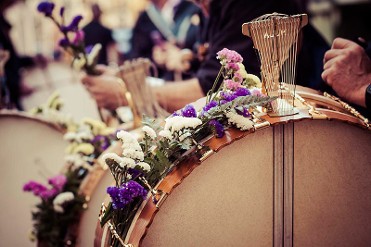
30170 MULA
Telephone: +34 968 661 501
If there is a special night in Mula is " The Drums night". The drums are sounding from 12.00 on Holy Tuesday to 16.00 on Holy Wednesday.
From XIX century , every year Mula has not broken this tradition which was associated to Mula inhabitants good behaviour and the prohibitions to walk around the streets with drums if there was not a procession. Following the fall of the Francoism, the drums started to have the support of authorities who saw in this custom an original festival offering the municipality a distinctive character . This helped the fetival was recognised as National Tourist Interest festival.
The tradition is repeated on Holy Friday and Easter Sunday.

Pza. del Castillo, s/n
30430 CEHEGÍN
Telephone: 968 723 550

Calles de Cehegín
30430 CEHEGÍN
Telephone: +34 968 723 550 / Fax: +34 968 723 555